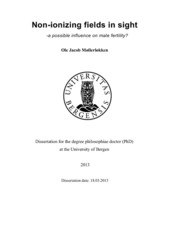| dc.contributor.author | Møllerløkken, Ole Jacob | en_US |
| dc.date.accessioned | 2013-07-11T08:49:39Z | |
| dc.date.available | 2013-07-11T08:49:39Z | |
| dc.date.issued | 2013-03-18 | eng |
| dc.identifier.isbn | 978-82-308-2251-7 (print version) | en_US |
| dc.identifier.uri | https://hdl.handle.net/1956/6796 | |
| dc.description.abstract | Background. Our society is increasingly using equipment that produces and emits non-ionizing electromagnetic fields (EMF), and little is known regarding exposure to such fields and the possible impact on male reproductive health. The main objective of this thesis is to gain more knowledge regarding the possible influence of nonionizing EMFs on male reproduction. Material and methods. The Royal Norwegian Navy (RNoN) had specific concerns regarding non-ionizing EMFs and reproductive health, as there were worries related to work on-board a specific vessel, namely the “Kongelig Norsk Marine (KNM) Kvikk”. Papers I and II were the result of cross-sectional studies conducted among all employees in the RNoN in 2002 by means of questionnaires. Paper I used self-reported exposures, and the questionnaire included variables regarding work history, physical health characteristics, education, diseases and reproductive health. In paper II the same questionnaire was used, and an expert panel categorized 18 work categories among the military men in the RNoN in terms of exposure or non-exposure to non-ionizing EMFs. Paper III was a dosimeter study on electric (E) fields on-board two vessels in the RNoN, a missile-torpedo boat (MTB) and a submarine. Personnel on-board wore the instrument in their breast pocket during their shifts and answered questions regarding location on-board and work tasks performed. In addition, the vessel’s activity and use of non-ionizing EMF-emitting equipment was noted. Paper IV was a prospective randomized balanced cross-over study of magnetic resonance imaging (MRI) and influence on hormones relevant for male reproduction. Twenty-four male medical students who met a number of inclusion criteria were investigated by means of serum-blood samples immediately before and after a real and sham MRI investigation. Results. Response rate in the cross-sectional studies (Paper I and II) was 58 per cent (n=2265) among all personnel (military and civilian personnel) and 63 per cent (n=1487) among the military men. The prevalence ratio (PR) of having a child with congenital anomaly was 4.0 (confidence interval (CI) 1.9 - 8.6) among the personnel who had served on-board the “KNM Kvikk”. Among the same personnel, the PR of having a stillborn child or a child that died within one week of birth was 4.1 (CI 1.7 - 9.9). In paper II, three work categories were classified as exposed to non-ionizing EMFs: “tele/communication”, “radar/sonar” and “electronics”. Logistic regression adjusted for age, whether the subject had ever smoked, military education and physical exercise at work displayed an increased odds ratio (OR) of 1.72 (CI 1.04 - 2.85) among “tele/communication” workers and OR of 2.28 (CI 1.27 - 4.09) among “radar/sonar” workers for self-reported infertility compared to unexposed workers. “Electronics” did not display an increased OR for self-reported infertility compared to the unexposed workers. In paper III, a total of 56 measurements were conducted on Efields on-board two vessels in the RNoN. The E-field values measured were very low, averaging 0 – 10 per cent of the guidelines given by the International Commission on Non-Ionizing Radiation Protection (ICNIRP). In paper IV, there was no change seen in hormone levels either immediately after exposure or within the next 11 days when persons exposed to real and sham MRI were compared. Conclusion. Paper I displayed an increased PR for having children with congenital anomalies, stillbirths or perinatal deaths after having served on-board a specific MTB vessel in the RNoN. Paper II showed an increased OR for self-reported experience of infertility among personnel serving in work categories categorized as being exposed to non-ionizing EMFs. Paper III investigated and described very low exposure for Efields measured on-board two RNoN vessels. Paper IV did not find evidence for a significant impact on hormones relevant for male reproduction after exposure in MRI. This thesis could not establish non-ionizing EMFs as a cause for the findings in paper I and II. Furthermore, the studies could not explain the findings using other factors. The difference in exposure levels and duration may be of importance, as well as confounding factors that have not been investigated in this thesis. | en_US |
| dc.language.iso | eng | eng |
| dc.publisher | The University of Bergen | eng |
| dc.relation.haspart | Paper I: Magerøy N, Møllerløkken O J, Riise T, Koefoed V, Moen B E. «A higher risk of congenital anomalies in the offspring of personnel who served aboard a Norwegian missile torpedo boat». Occupational and Environmental Medicine 2006; 63: 92–97. Full-text not available in BORA due to publisher restrictions. The published version is available at: <a href="http://dx.doi.org/10.1136/oem.2005.021113" target="blank"> http://dx.doi.org/10.1136/oem.2005.021113</a> | en_US |
| dc.relation.haspart | Paper II: Møllerløkken O J, Moen B E. «Is fertility reduced among men exposed to radiofrequency fields in the Norwegian Navy?». Bioelectromagnetics 2008; 29: 345–352. Full-text not available in BORA due to publisher restrictions. The published version is available at: <a href="http://dx.doi.org/10.1002/bem.20400" target="blank">http://dx.doi.org/10.1002/bem.20400</a> | en_US |
| dc.relation.haspart | Paper III. Møllerløkken O J, Moen B E. «Electrical fields onboard two minor navy vessels». Medicina Maritima 2007; 7: 60–70. Full text not available in BORA. | en_US |
| dc.relation.haspart | Paper IV: Møllerløkken O J, Moen B E, Baste V, Magerøy N, Oftedal G, Neto E, Ersland L, Bjørge L, Torjesen P A, Hansson Mild K. «No effects of MRI scan on male reproduction hormones». Reproductive Toxicology 2012; 34: 133–139. Full-text not available in BORA due to publisher restrictions. The published version is available at: <a href="http://dx.doi.org/10.1016/j.reprotox.2012.04.003" target="blank">http://dx.doi.org/10.1016/j.reprotox.2012.04.003</a> | en_US |
| dc.title | Non-ionizing fields in sight - a possible influence on male fertility? | en_US |
| dc.type | Doctoral thesis | |
| dc.rights.holder | Copyright the author. All rights reserved | |

